| Instruction manual - Pizzicato 3.6.2 | EN630 - Revision of 2013/05/29 |
Editing a synthesizer
Subjects covered:
Access to synthesizers configurations [Professional] [Composition Pro]
A set of configurations, each one representing a synthesizer of the market, is provided with Pizzicato. It can be useful to personalize a synthesizer, for example if you modify the sound setup in it. If your synthesizer is not in the provided original list, you can create a new configuration and introduce in it all parameters and characteristics of your synthesizer.
You can reach it by opening the Select synthesizer dialog box.
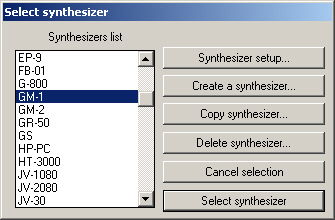
As we have already studied, this dialog box allows you to select the synthesizer associated with a Midi port. The first four buttons are used to modify and complete the list. We will make a copy of the Sc-55 synthesizer in order to be able to make modifications in this lesson.
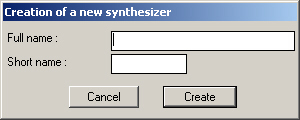
A synthesizer has a full name and a short name. Fill in for example Test in the two text boxes and click Create. Pizzicato copies Sc-55 and calls it Test. The configuration dialog box appears :
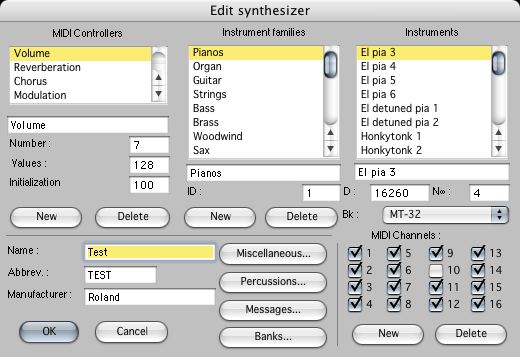
The dialog box is divided into 4 distinct areas which we will study by order of importance.
By using the instruments view, the user has two menus to select a sound. The first selects the family of the instrument (for example Strings) and the second allows to select one of the sounds belonging to the selected family (for example Cello).
The middle list contains the families of instruments defined for this particular synthesizer. By selecting a family of this list (by simply clicking on its name), the instruments defined in it appear in the list next to the right. In order to understand how to modify these lists, we will create a new family and add an instrument in it.
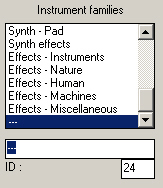
A new line is added at the end of the list. The text box located just below lets you fill in the name of the new family. Type Test family on the keyboard. As you type it in, the text appears in the list. In Pizzicato, each family has an identification number, shown here by a number (24) called ID (Identifier). When you create a family, Pizzicato automatically assigns the next available number. You can modify it by using the text box which contains it. If you create a synthesizer from scratch, we advise you to keep families and identifiers used by other synthesizers, so as to ensure a compatibility with future versions of Pizzicato.
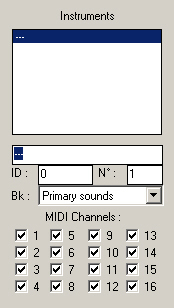
The main sounds available on a synthesizer are represented by a number from 1 to 128 (or sometimes from 0 to 127 according to the manufacturer). You should find the list with the correspondence between names and numbers in the synthesizer manual. This number must be placed in the text box entitled "N°". By creating an instrument, this number is set at 1 by default.
At the beginning of the MIDI system, 128 different sounds largely met the needs of synthesizers. With the evolution of the technical power, the current synthesizers always offer more sounds and the limit of 128 different sounds is almost always exceeded. The Midi message directly selecting a sound only accesses 128 different sounds. To go beyond this limit of 128, manufacturers use various additional messages allowing to divide the sounds into various Sound banks. Specific Midi messages (sometimes peculiar to each manufacturer) select a sound bank. One can thereafter select a sound in this bank by sending a number from 1 to 128. The sound bank to which the instrument belongs may be selected in the menu labeled Bk. Combined with the number (N°), Pizzicato can use this information to select the sound chosen by the user.
The 16 boxes located below show the possibility of using this sound on the 16 Midi channels of the synthesizer. When Pizzicato automatically allots the Midi channels, these boxes specifies to it which channels can used for this sound. The Midi channel 10 is often allocated to the percussions sets. By defining an instrument which is not a percussions set, uncheck channel 10. If you define an instrument corresponding to a percussions set, check channel 10 and disable all others, so that it will force Pizzicato to use channel 10 when the user selects a percussion set.
So as to be able to convert a score written for different synthesizers, an identifier is associated with each sound. It is shown in the text box entitled ID. "0" means that the conversion must not be done. IDs from 1 to 128 correspond to the standard GM (General Midi) sounds. When Pizzicato loads a score written for a synthesizer and different from your current selected synthesizer, it automatically converts the numbers of the sounds so that they correspond to the same instruments. This operation is done only if the identifiers are present in the configurations of the concerned synthesizers. If you want to use this aspect, you just need to associate each instrument to an ID corresponding to the number of the equivalent instrument in the GM system.
By following the method described above, you can thus add families. To add an instrument, select the family and then add it in the next list.
To erase an instrument, click to select it and then click the Delete button located under the instruments list. The instrument disappears from the list.
Similarly, to erase a family, select it on the list of families and click the Delete button located under this list. The family is erased and the instruments in it are not visible any more. They are not erased thought, because if you recreate a family with the same identifier as the erased family, the instruments will come back there when you select this family on the list.
The left list is used to define the Midi controllers to which the synthesizer can answer. The selection principle is the same as for families and instruments. By clicking on a line, the associated characteristics are displayed in the text boxes located below the list.
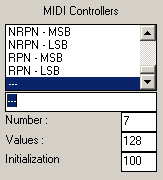
Midi controllers are messages which can be received by the synthesizer and modify various aspects of sound. There are 128 possible controllers but only the significance of a small number of them is really determined. To find a full list of them, please consult a specialized book. Also consult the configurations of synthesizers provided with Pizzicato.
A section of a synthesizer manual usually shows which Midi controllers it can answer. It is the Midi Implementation Chart which is often at the end of the manual. With it we have encoded the provided configurations. For example, we will add the sound reverberation controller which bears number 91.
To erase a Midi controller, select its line and click the Delete button located under the controllers list.
In the left lower part of the dialog box, you find the full name, the short name and the manufacturer. Four buttons give you access to 4 different dialog boxes: Miscellaneous, Percussions, Messages and Banks.
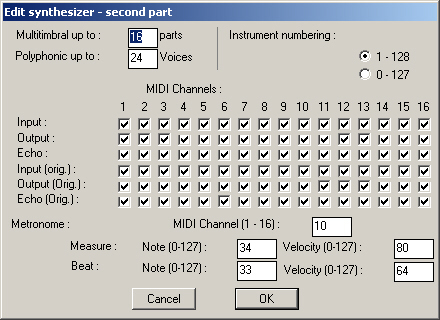
The text box entitled Multitimbral up to… parts specifies the number of different sounds the synthesizer can generate simultaneously.
The Polyphonic up to ... voices specifies the maximum number of notes which can be played simultaneously, all sounds together.
A multiple choice specifies if the classification of sounds is expressed from 1 to 128 (Roland, Yamaha, Korg) or from 0 to 127 (Proteus for example). The numbers introduced by creating the instruments must correspond to the choice selected here.
The central part of the dialog box contains 6 lines of check boxes. For each line, the 16 columns correspond to the 16 Midi channels of your synthesizer.
- The fourth line is entitled Input (orig.). It shows the Midi channels from which your synthesizer can receive information. Usually, the 16 channels are used, but it depends on the synthesizers. The oldest ones sometimes receive only one channel at the same time (Dx-7 of Yamaha). The others must then be disabled.
- The first line (entitled Input) is at first the same as the fourth. You can modify it to personalize your Midi configuration. Here is a possible example of use. Let us take the case where you connect two synthesizer (A and B for example) on the same Midi output of your MIDI interface. At the origin, A and B can both receive 16 Midi channels. As it is the same Midi cable, if you send notes on channel 1, both synthesizers will play them, which is not necessarily what you want. The solution consists in disabling channels 1 to 8 on B and channels 9 to 16 on A. For that, consult the manual of your synthesizer, because it changes from one model to another. Then, you must tell Pizzicato that it can only use channels 1 to 8 for synthesizer A. In the first line of the above dialog box, disable channels 9 to 16. Similarly, in the configuration dialog box of synthesizer B, disable boxes 1 to 8 of the first line. When you select an instrument belonging to A, Pizzicato will only use the first 8 channels and there will be no more possible confusions.
- Line 5 relates to the Midi output of the synthesizer. The active boxes are the channels which can emit in Midi.
- Line 2 is the same one and can be modified by the user.
- The same principle is applicable for lines 6 and 3, which specify if the synthesizer sends each Midi channel in echo via its Thru output. Lines 2,3,5 and 6 are not used by the current version of Pizzicato and are planned for possible future extensions.
The lower part of the dialog box determines the metronome characteristics and the Midi channel can be selected. The notes and their velocity can be specified by text boxes, as well for the start of a measure as for beats which divide the measure. Note 60 corresponds to the treble clef low C. Click OK.
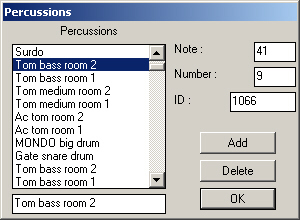
This dialog box is used to define percussion sets contained in the synthesizer. Most synthesizers propose one or more sonorities representing for each note of the keyboard a percussion instrument. It is also the case for some special effects like laughs, steps, rain, applause… Midi channel 10 is often reserved for these percussion configurations. When several are present, it is necessary to send a program change message (1 to 128, as for the instruments) which selects the desired configuration.
The instruments representing these percussions must be encoded as others and must be classified exclusively in the Percussions - Kits family (ID = 21).
For each configuration, the detail of each keyboard note should be located in the synthesizer manual and can be entered using the above dialog box.
Click Add. You get:
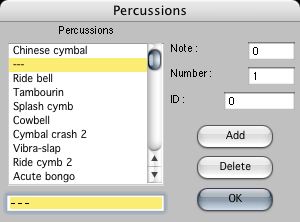
A new line is added below the selected line. Type for example Bongo-1 on the keyboard. It is the name of the instrument. Three text boxes are associated to this instrument. The first gives the number of the note which activates it on the keyboard. Its value can be between 0 and 127, 60 corresponding to the treble clef low C. This value is normally specified in the percussion instruments list of your synthesizer manual. The number located below is the number of the percussion configuration. It corresponds to the number (from 0 to 127) used to select this configuration in Midi. The following number is an identifier which is used by Pizzicato to do an automatic conversion of percussions when you load a score composed with a synthesizer different from your current selected one. "0" means that no conversion is done. The numbers from 1 to 128 correspond to the GM configuration. When you create a percussion instrument, associate with it the number of the equivalent GM note and add "1" to it.
To erase a percussion instrument, select it on the list and click Delete.
Click OK.
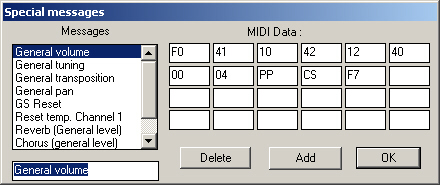
It is used to define special messages (also called exclusive messages) which can be sent to the synthesizer. The use of the exclusive Midi messages requires a very good understanding of your synthesizer, of the Midi system and hexadecimal notation (counting system which uses figures 0 to 9 and letters from A to F). Some information which follows is thus intended to the specialists, because the complete explanations would leave the framework of this course. If you wish to look further into these aspects, consult a specialized book on MIDI. The use of the exclusive Midi messages gives you access to all internal features of your synthesizer.
To create a new message, click Add and give it a name. You have 24 bytes maximum to structure the message. They must be specified by two hexadecimal digits. Some codes are used to parameterize the message. When you send one of these messages, the parameters are then replaced by the values given with the message (there can be 4 parameters, see the instruments view and its column "ms"). Here are the codes you can use:
- - P: this code replaces a parameter of a value between 0 and 15 (0-F). When the parameter is replaced, it is placed in the least significant bits of the Midi byte. The resulting value in fact is added with the preceding byte to form a byte of the Midi message.
- P: it is the same but when the parameter is replaced, it is placed in the most significant bits of the Midi byte. The resulting value in fact is added with the preceding byte to form a byte of the Midi message.
- PP: this code places the value of a parameter in the Midi message. It can take the values from 00 to FF.
- CS: this code calculates the Check Sum for the Roland exclusive messages.
- - C: this code places the MIDI channel number (0-F) in the least significant bits of the preceding byte. The Midi channel is the one set by the instruments view.
- C: this code places the MIDI channel number (0-F) in the most significant bits of the preceding byte. The Midi channel is the one set by the instruments view.
To consult or modify a message, click it in the list. Its contents is then displayed in the 24 text boxes. To erase it, use Delete button.
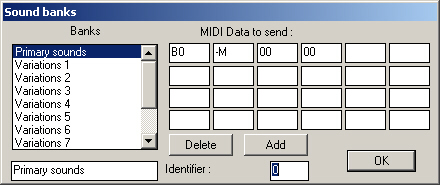
It allows you to create/delete/modify sound banks. Each bank defined in the list contains a name, an identifier and 24 bytes (to the maximum) used to define the Midi message associated with the sound bank. The principle is similar to the preceding dialog box. The bytes must be defined in hexadecimal and the following codes is used to insert Midi channel in the message:
- - M inserts the Midi channel in the least significant bits.
- M inserts the Midi channel in the most significant bits.
When Pizzicato needs to select a sound bank, it sends this message on the Midi channel associated with the concerned staff. This message depends on your synthesizer and it is normally found in the Midi characteristics of its manual.
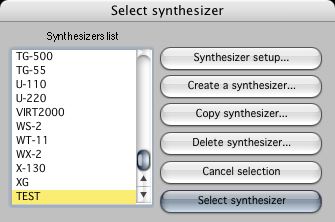
If you wish to consult or modify another synthesizer, select it in the list and click Synthesizer setup… You will get the same dialog box as above. If you wish to look further into this aspect of Pizzicato, we suggest you consulting several different synthesizers in order to see how they were encoded.
The button Create a synthesizer… initializes a new synthesizer in which all lists of instruments, families, percussions,... are empty. If you wish to encode new synthesizers, we advise you to start with the synthesizer called Modele-1 in the list and to click Copy synthesizer by giving it a new name. Modele-1 contains already the main standard Midi controllers as well as the families with their identifiers.